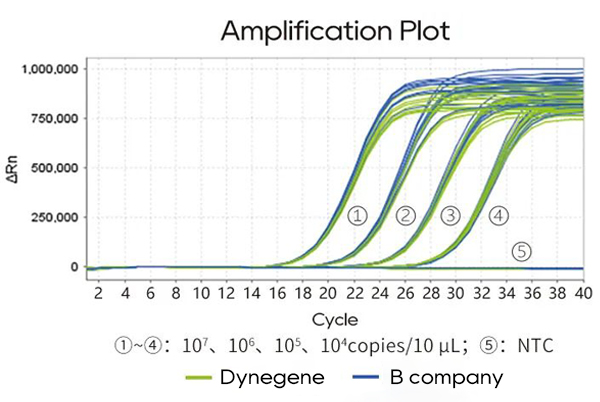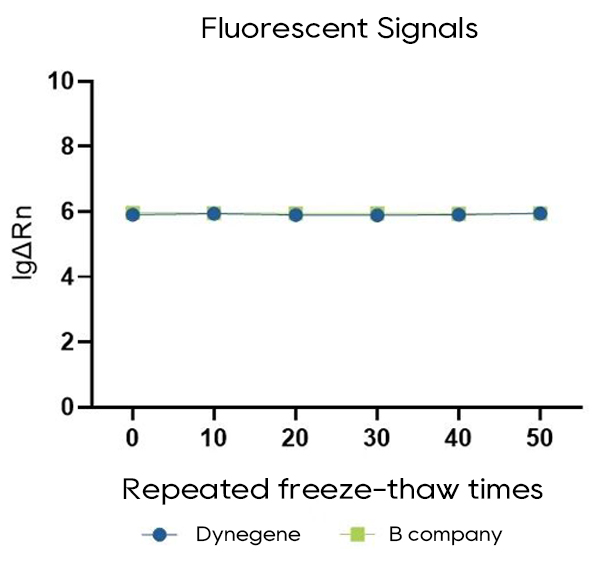Taqman probe method for qPCR has strong specificity and high sensitivity compared with dye method, and has been widely used in molecular diagnosis, microarray sequencing, human genome engineering, tumor research, forensic identification and other various fields.
With professional technicians, advanced DNA synthesizers and mature synthesis and purification methods, Dynegene has launched custom TaqMan probe service, providing various types of fluorescent modifications according to customer needs; and strictly implementing ISO13485 quality control standards to ensure first-class quality and timely delivery.
Product Highlight
Purity assurance: Each probe is purified by HPLC to ensure product quality
Good consistency: Good consistency between intra or inter batch
High sensitivity: Detectable down to 1 copy/ µL
Good stability: Stable performance under repeated freeze-thaw and 37°C thermal acceleration
Performance Demonstration
Purity assurance


Dynegene strictly implements ISO13485 quality control standards, and the synthesized probes are purified by HPLC with a purity of over 90%. To ensure product quality, each sequence is tested by mass spectrometer and a test report is issued.
Good consistency

The MPV plasmids (107, 106, 105, 104 copies/10 µL) were assayed with three different batches of probes synthesized by Dynegene. The results showed that the CT values were stable with the same plasmids copies, which implies good consistency.
High sensitivity

The MPV plasmids (108, 107, 106, 105, 104, 103, 102, 10 copies/10 µL) were detected with probes synthesized by Dynegene, and the results showed that even 1 copy/µL could be detected, which implies high sensitivity.
Good stability


The probe was subjected to repeated freeze-thaw for 50 times, or thermal acceleration treatment at 37℃ for 7d. The CT value remained stable with CV <1%. Besides, before and after the treatment the loss of fluorescence signal was less, which implies good stability.
Various types of fluorescent modifications are available according to customer requirements
Commonly used fluorescent groups

Commonly used quenching groups

Ordering information

 NGSHybridization Capture DNA Probe QuarStar Human All Exon Probes 4.0 (Tumor) QuarStar Human All Exon Probes 4.0 (Standard) QuarStar Liquid Pan-Cancer Panel 3.0 QuarStar Pan-Cancer Lite Panel 3.0 QuarStar Pan-Cancer Fusion Panel 1.0 QuarStar Pan Cancer Panel 1.0 Hybridization Capture RNA Probe QuarXeq Human All Exon Probes 3.0 HRD panel Library Preparation DNA Library Preparation Kit Fragmentation Reagent mRNA Capture Kit rRNA Depletion Kit QuarPro Superfast T4 DNA Ligase Hybridization Capture QuarHyb Super DNA Reagent Kit QuarHyb DNA Plus 2 Reagent Kit QuarHyb DNA Reagent Kit Plus QuarHyb One Reagent Kit QuarHyb Super Reagent Kit Pro Dynegene Adapter Family Dynegene Blocker Family Multiplex PCR QuarMultiple BRCA Amplicon QuarMultiple PCR Capture Kit 2.0 PathoSeq 450 Pathogen Library Corollary Reagent Streptavidin magnetic beads Equipment and Software The iQuars50 NGS Prep System
NGSHybridization Capture DNA Probe QuarStar Human All Exon Probes 4.0 (Tumor) QuarStar Human All Exon Probes 4.0 (Standard) QuarStar Liquid Pan-Cancer Panel 3.0 QuarStar Pan-Cancer Lite Panel 3.0 QuarStar Pan-Cancer Fusion Panel 1.0 QuarStar Pan Cancer Panel 1.0 Hybridization Capture RNA Probe QuarXeq Human All Exon Probes 3.0 HRD panel Library Preparation DNA Library Preparation Kit Fragmentation Reagent mRNA Capture Kit rRNA Depletion Kit QuarPro Superfast T4 DNA Ligase Hybridization Capture QuarHyb Super DNA Reagent Kit QuarHyb DNA Plus 2 Reagent Kit QuarHyb DNA Reagent Kit Plus QuarHyb One Reagent Kit QuarHyb Super Reagent Kit Pro Dynegene Adapter Family Dynegene Blocker Family Multiplex PCR QuarMultiple BRCA Amplicon QuarMultiple PCR Capture Kit 2.0 PathoSeq 450 Pathogen Library Corollary Reagent Streptavidin magnetic beads Equipment and Software The iQuars50 NGS Prep System Primers and Probes
Primers and Probes RNA SynthesissgRNA miRNA siRNA
RNA SynthesissgRNA miRNA siRNA



 Gene Synthesis
Gene Synthesis Oligo Pools
Oligo Pools CRISPR sgRNA Library
CRISPR sgRNA Library Antibody Library
Antibody Library Variant Library
Variant Library











 Tel: 400-017-9077
Tel: 400-017-9077 Address: Floor 2, Building 5, No. 248 Guanghua Road, Minhang District, Shanghai
Address: Floor 2, Building 5, No. 248 Guanghua Road, Minhang District, Shanghai Email:
Email: Tel: 400-017-9077
Tel: 400-017-9077 Address: Floor 2, Building 5, No. 248 Guanghua Road, Minhang District, Shanghai
Address: Floor 2, Building 5, No. 248 Guanghua Road, Minhang District, Shanghai Email:
Email: 







